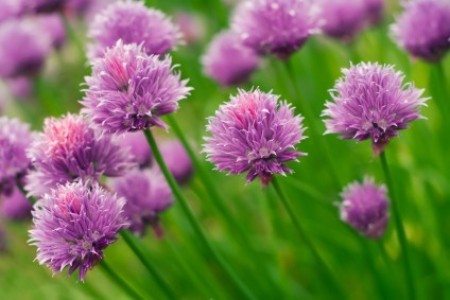
If you only have room to grow one type of herb in your garden, then consider growing chives. This common perennial herb is easy to grow and definitely earns its keep. The spiked foliage and globe-shaped flowers are attractive in the garden, tasty in the kitchen, and they also help repel insects for neighboring plants.
Chives come in two basic types: common chives (Allium schoenoprasum) and garlic chives (Allium tuberosum). Like their relatives the onion, chives grow from bulbs, but it's their leaves and flowers that are harvested for culinary purposes.
Common chives have globe-shaped pink to lavender flower heads and hollow, tubular-shaped leaves. The flowers and leaves are both edible and the delicate onion flavor of their leaves is frequently used in salads, sauces, egg dishes, and as a garnish.
Garlic chives, also called Oriental or Chinese chives, have flat, hollow leaves and white flower blossoms. Their leaves have a mild garlic flavor useful for adding spice to soups, salads, sauces, and meat dishes. Garlic chives can be invasive in some areas.
Chives can be started from seeds, but their slow growth means waiting up to two years for small-sized plants. It's better to purchase young plants from a nursery or acquire divisions from a friend of neighbor.
Plant them in a sunny location, in rich well-drained soil and mulch lightly around the base to prevent weeds and conserve moisture. Avoid planting chives in wet areas or heavy soils, which can encourage stems and bulbs to rot.
Deadhead flowers throughout the summer to keep plants from going to seed. This is especially important for garlic chives, which can quickly become invasive due to self-seeding. In cool climates, divide clumps every 3 years in the early spring. In hot climates, divide them in the fall.
Chives can also be planted in containers or potted up at the end of summer and brought indoors. At the end of summer, cut back a few of the tufts to the ground and transplant the clumps into a pot. Bring them inside and place them near a sunny windowsill to enjoy fresh chives all winter.
To keep chive plants growing vigorously, use a scissors to snip off whole tufts about 1 inch from ground level. Avoid snipping off small portions, which will result in the remaining tips developing yellow leaves. Harvest often, but if the tufts are large, harvest only half of the plant at any one time.
After cutting, remove any yellow leaves, then rinse them and pat them with a paper towel. Chives don't dry well - their leaves and flavor fade over time. It's better to harvest them and use them fresh, or freeze them. To freeze, fold a tuft in half and place in a small freezer bag. Snip off small portions to use as needed.
The mild onion (or garlic) flavor of chives lends itself well to many culinary uses. Chop them and add to salads, meat, egg and cheese dishes, cream cheese, potatoes, sandwich spreads, and sauces. The little purple flowers are also edible. Add them to white vinegar or use them as a lovely garnish.
One of the more popular ways chives are used is as a component in the traditional herbs mixture of French cuisine called, "fines herbes", which contains equal portions of chives, tarragon, chervil, and/or parsley.
Chives' spiky, blue-green foliage and clover-like, globe-shaped flowers make a striking addition to the garden landscape. Plant them in clumps, or arrange them in straight rows as an edging plant along low borders, in vegetables gardens, or flower beds. Their onion-like leaves contain sulfur, and when planted among roses and tomatoes, they are said to help protect them from black spot, Japanese beetles, and other insects.
Common Chives (Allium schoenoprasum)
Type: Hardy perennial; zones 3-9.
Height: 6-10 inches.
Spread: 12 inches.
Flowers: June; pink to lavender (common chives); white (garlic chives).
Harvesting: Cut leaves close to the ground; cut often.
Preserving: Use fresh or freeze; grow in winter by potting a few clumps in fall and placing near a sunny window.
Propagation: Lift and divide clumps every 3 years.
Companion plants: Recommended for carrots, grapes, roses, and tomatoes.
Wildlife: Not bothered by deer or rabbits. Oniony taste of leaves repels many insects; flowers are attractive to bees.

About The Author: Ellen Brown is an environmental writer and photographer and the owner of Sustainable Media, an environmental media company that specializes in helping businesses and organizations promote eco-friendly products and services. Contact her on the web at http://www.sustainable-media.com
Add your voice! Click below to comment. ThriftyFun is powered by your wisdom!
Add your voice! Click below to comment. ThriftyFun is powered by your wisdom!